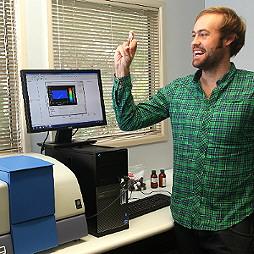Posted 8 July 2012

Josh Larsen analysing water samples from Queensland mangrove systems with the new instrument.
The Connected Waters Initiative team has taken delivery of a new instrument specifically designed for the analysis of fluorescent organic matter in aquatic systems.
The Horiba Aqualog spectrofluorimeter is the first in Australia.
Dissolved organic matter occurs in all water, from ground and surface water to drinking water, and is usually naturally fluorescent.
The Aqualog induces this fluorescence and measures the amount of emitted light.
From these measurements it is possible to both measure and characterise the dissolved organic matter in a water sample.
Most importantly, the analyses require little or no sample preparation, allowing rapid measurement time.
The Aqualog forms part of a suite of instrumentation at the CWI for research and teaching. This includes Turner Designs in-situ fluorescence probes for in-bore organic matter characterisation and an Agilent Cary-50 UV-VIS spectrometer.
The Aqualog has already been used in the analysis of groundwater samples by Dr Adam Hartland from recent fieldwork in the Liverpool Plains and the analysis of water samples from Queensland mangrove systems by Dr Josh Larsen (pictured) in collaboration with the NCGRT's Dr Nina Welti (University of Queensland).
It is next heading to the UNSW Wellington Field Station to analyse ground and surface water samples from the Wellington Caves GEIF site and to be used for teaching field methods to 23 UNSW undergraduate and Masters groundwater scientists.
Further reading:
Mudarra, M., Andreo, B. and Baker, A. 2011. Characterisation of dissolved organic matter in karst spring waters using intrinsic fluorescence: relationship with infiltration processes. Science of the Total Environment, 409, 3448-3462
Hudson, N.J., Baker, A. and Reynolds, D. 2007. Fluorescence analysis of dissolved organic matter in natural, waste and polluted waters - a review. Rivers Research, 23, 631-649.
Baker, A. and Lamont-Black J, 2001. Fluorescence of dissolved organic matter as a natural tracer of ground water. Ground Water, 39: 745-750.
Baker, A., Mockler, N.J. and Barnes, W.L., 1999. Fluorescence intensity variations of speleothem forming groundwaters: implications for palaeoclimate reconstruction. Water Resources Research, 35, 407-413
Links

Professor Andy Baker features in American Water Resources Association ‘Water Resources Impact’, September 2020 edition.

The Connected Waters Initiative (CWI) is pleased to welcome Taylor Coyne to its network as a postgraduate researcher. If you’re engaged in research at a postgraduate level, and you’re interested in joining the CWI network, get in touch! The CWI network includes multidisciplinary researchers across the Schools of Engineering, Sciences, Humanities and Languages and Law.

The Grand Challenge on Rapid Urbanisation will establish Think Deep Australia, led by Dr Marilu Melo Zurita, to explore how we can use our urban underground spaces for community benefit.

On the 21 August 2020, CWI researchers made a submission to the National Water Reform Inquiry, identifying priority areas and making a number of recommendations as to how to achieve a sustainable groundwater future for Australia.

Results published from a research project between the Land Development Department (LDD) Thailand and UNSW has demonstrated how 2-dimensional mapping can be used to understand soil salinity adjacent to a earthen canal in north east Thailand (Khongnawang et al. 2020).